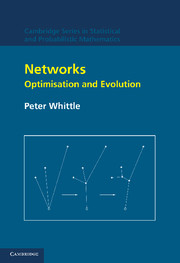Book contents
- Frontmatter
- Contents
- Acknowledgements
- Conventions on notation
- Tour d'Horizon
- Part I Distributional networks
- Part II Artificial neural networks
- Part III Processing networks
- Part IV Communication networks
- 15 Loss networks: optimisation and robustness
- 16 Loss networks: stochastics and self-regulation
- 17 Operation of the Internet
- 18 Evolving networks and the Worldwide Web
- Appendix 1 Spatial integrals for the telephone problem
- Appendix 2 Bandit and tax processes
- Appendix 3 Random graphs and polymer models
- References
- Index
17 - Operation of the Internet
Published online by Cambridge University Press: 23 November 2009
- Frontmatter
- Contents
- Acknowledgements
- Conventions on notation
- Tour d'Horizon
- Part I Distributional networks
- Part II Artificial neural networks
- Part III Processing networks
- Part IV Communication networks
- 15 Loss networks: optimisation and robustness
- 16 Loss networks: stochastics and self-regulation
- 17 Operation of the Internet
- 18 Evolving networks and the Worldwide Web
- Appendix 1 Spatial integrals for the telephone problem
- Appendix 2 Bandit and tax processes
- Appendix 3 Random graphs and polymer models
- References
- Index
Summary
These last two chapters are intended as something of a corrective: to give significant examples of newer types, concepts and models of communication networks. This chapter continues the preoccupation of Chapter 16 with operation rather than design: to find rules that make effective use of poor and local information to achieve smooth operation of a rather diffuse system. The design aspect makes a natural return in Chapter 18; both the Internet and the Worldwide Web achieve their own design, partially at least, by a kind of directed evolution.
For loss networks a call was not accepted unless an open path from source to destination could be guaranteed. Once the connection was established, delivery of the message could begin. The Internet operates by packet-switching rather than circuit-switching. The ‘message’ is seen as a prepared file rather than a real-time conversation. This file is broken into ‘packets’ which are launched successively into the system, with no guarantee of an open path along the required route. The role of an ‘exchange’ is replaced by that of a ‘router’: a device that sorts packets as they arrive on incoming links and directs them on to the outgoing link appropriate for their destination. Each of these outgoing links is prefaced by a ‘buffer’, a queue that will store packets until there is free capacity on the link. The buffer is finite, however; once its capacity has been exceeded the overflow of packets is lost.
Final loss is not permitted, however, because the packets must be assembled at the destination to reconstitute the original file. If any packet is missing then transmission of the file is unacceptably impaired.
- Type
- Chapter
- Information
- NetworksOptimisation and Evolution, pp. 211 - 218Publisher: Cambridge University PressPrint publication year: 2007



